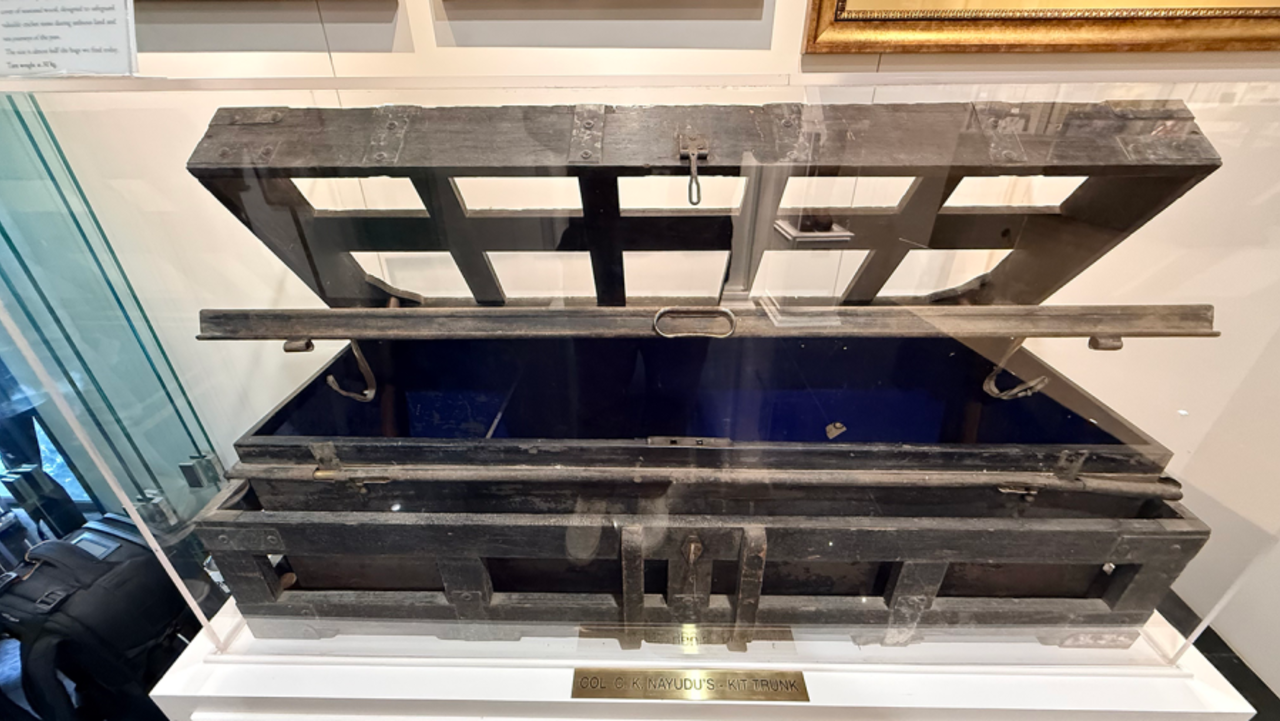CK Nayudu's kit bag, Syed Mushtaq Ali's letter
There are so many pieces of history to see at the cricket museum in Holkar Stadium
S Sudarshanan
22-Oct-2025

Heavy load: CK Nayudu's kit bag weighed 30kg by itself • S Sudarshanan/ESPNcricinfo Ltd
Kitbags have always been a fascinating part of the game, treasure troves carrying all the tools of a cricketer's trade. If, like me, you live in Mumbai, it's not out of the ordinary to see kids lugging these unwieldy pieces of luggage into crowded local trains, like Sachin Tendulkar, Rohit Sharma, and so many others before them did.
Even so, I wasn't prepared for the piece of history I saw when I walked into the museum at the Holkar Stadium in Indore. The metal trunk that India's first Test captain, Colonel CK Nayudu, used as his kitbag weighed 30kg when empty! It looked more like the old-style trunks you now see double up as furniture in many homes around India. This trunk also had an outer case for extra protection from water during sea voyages.
The museum, inaugurated three months ago, also displays Nayudu's army uniform; he was conferred the rank of colonel in 1923 by the Holkar state, whom he captained in the Ranji Trophy.
The other slice of history that finds a spot right by the museum's entrance is a pitch roller from 1907. A multi-directional roller that could also be pulled by horses back in the day, it was made in Mumbai and was in use until it was retired this June. The roller's weight could be increased or decreased by shifting the louvres on both sides.

The balls from the first women's international at Indore's Holkar Stadium, and from the last women's match at Nehru Stadium•S Sudarshanan/ESPNcricinfo Ltd
The Holkar Stadium is currently hosting its first Women's World Cup matches, but the city of Indore previously staged a Women's World Cup match, at the Nehru Stadium in 1997. The ball used in that game between India and New Zealand, the last tied game at a Women's ODI World Cup, is displayed in the museum.
You'll also get to see many other interesting cricketing artefacts: Kapil Dev's "mongoose" bat, with which he scored the famous 175 not out in the 1983 World Cup; bats belonging to Tendulkar, Sunil Gavaskar and Don Bradman; BCCI annual reports from the late 1940s and early 1950s; and a copy of a letter postponing the BCCI's annual general meeting from August 10 to August 15, 1947, the day India gained independence from Britain.

Syed Mushtaq Ali's letter to a journalist•Daya Sagar/ESPNcricinfo Ltd
An exhibit that I personally found heartwarming was a letter of appreciation from Syed Mushtaq Ali - a huge photo of whom adorns one section of the outer wall of the museum, which is called the "Wall of Firsts", for being the first Indian to score an overseas Test hundred. (His fellow opener, Vijay Merchant, also scored a hundred in the same innings, at Old Trafford in 1936). It was addressed to a journalist for a story in a newspaper, a gesture that we rarely get to see these days.
S Sudarshanan is a sub-editor at ESPNcricinfo. @Sudarshanan7